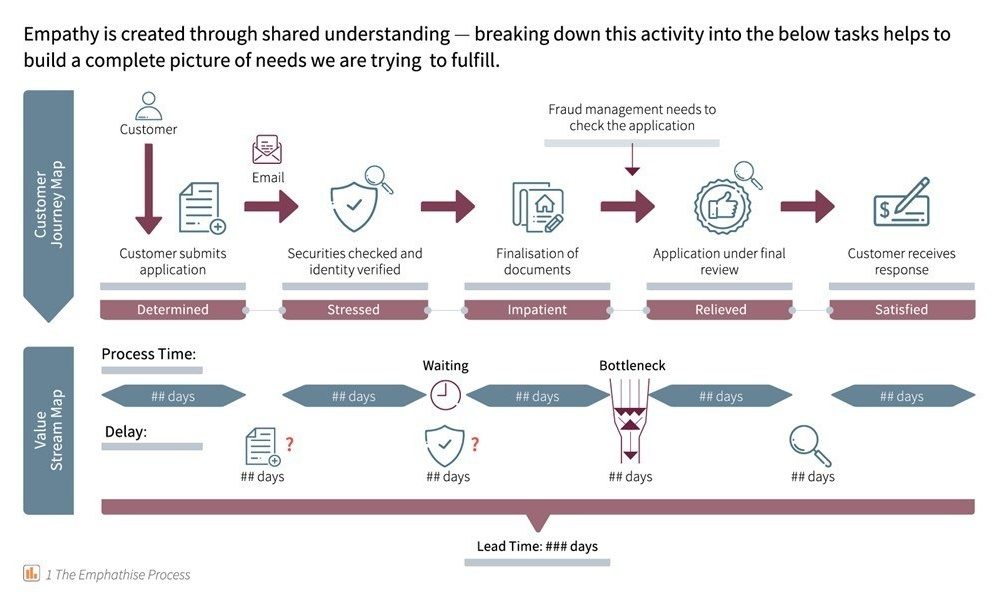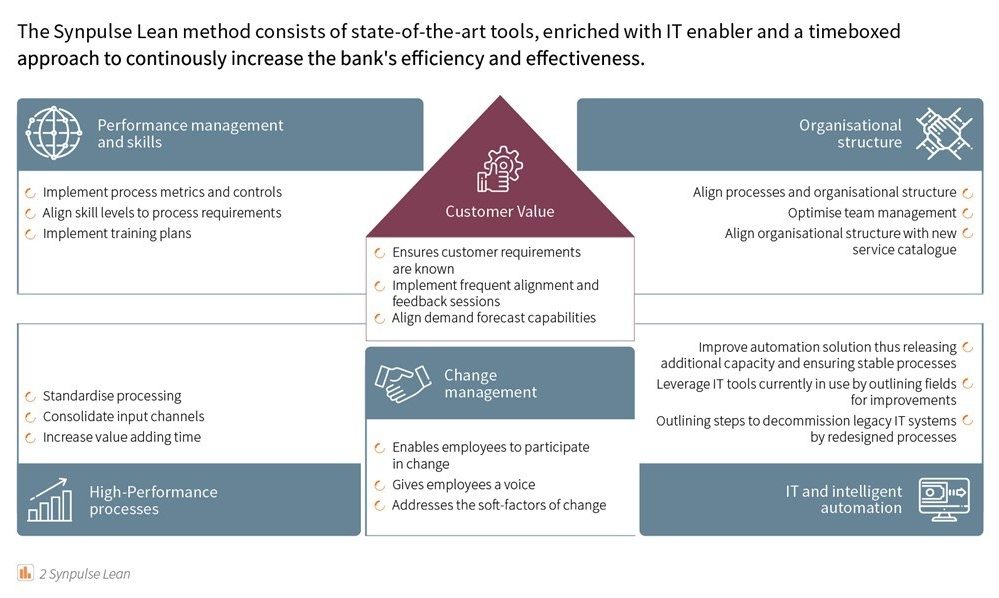Most Financial institutions (FIs) today are overweight. Structurally, they are large bodies comprising of many silo units, each moving to its own tune. Additionally, recent technological innovations have resulted in fintech and non-traditional players entering the market with a new wave of productivity. Without drastic measures to eliminate waste and develop superior client value, banks will lose their competitive edge.
FIs in APAC need to improve their productivity levels while also keeping up with the competition from FinTechs and other non-traditional players to offer better client experience. And to keep up with this challenge, FIs must continuously undergo transformation.
How, then, do FIs successfully transform to stay relevant and appeal to clients continuously and efficiently?
Adopting lean principles alongside a client-centred design approach, the client journey could be the answer to creating maximum value for clients and the organisation, all while improving operational efficiency.
What creates a lean diet for the client journey?
With any good diet, the first step is to ensure that the goal is clearly defined. FIs should clearly define their goals by analysing the client journey and understanding their clients’ emotional expectations and needs that can be met by their products and services.
Observing the clients’ needs can be deceptively straightforward. A superficial understanding can lead to a mismatch between the bank’s provided value and your clients’ actual needs. The best way to know what your client wants is to take a step back and walk in their shoes by mapping their journey
A client journey map is a visual representation of how a client interacts with the FI. While mapping the journey, we empathise with the client and capture their emotions throughout their engagement with the FI. Instead of simply looking at specific experiences in isolation, the client journey documents the full experience and all possible touchpoints. This allows the FI to easily identify gaps in the processes between departments or channels, which cause disjointed and unpleasant experiences for the client
Much like how miracle weight loss regimes are usually too good to be true, client journey mapping is not without its limitations. The client journey map focuses on the client but tends to ignore the employees responsible for these client touchpoints.
Stakeholders such as the product management or engineering teams should be involved in order to have a complete understanding of the complexities of any proposed solution. Leaving these stakeholders out leads to action plans that are either unachievable or too focused on only short-term solutions.
To avoid this, the client journey map must be accompanied by a parallel process that looks internally and evaluate whether actions add value and compare them against the clients’ needs. One such process is value stream mapping.
With the transformation goals clearly defined, applying lean principles to eliminate process waste and create client value becomes significantly more effective.
Value Stream: Are your internal processes lined up to create efficiency?
It is common knowledge that exercise is important to maintain a healthy lifestyle, but what one puts into their body is as crucial. Just as client journey mapping gives an external perspective on the clients’ needs, it needs to work hand in hand with value stream mapping, which looks at the same issues from an internal perspective. Creating client value can only be done properly when we examine how FIs can improve holistically both from an external and internal perspective.
Organisational silos that exist within many FIs and the decentralised nature of its activities, coupled with the silo mentality, are the cause of many inefficiencies within the FIs. These inefficiencies can be avoided by looking at the process from the inside out through Value Stream Mapping.
Looking at the processes through a value stream map, it prevents FIs from overlooking the overall waste that is produced. Mapping the value stream provides a unified overview of the processes, which allows everyone from senior management to the operations team to be on the same page. This platform can then be used by all stakeholders across different levels — from the management level to the individual process level — to objectively evaluate processes with key performance indicators based on the clients’ needs.
Through an analysis of the complete value stream, the end-to-end processes are visualised and mapped to accurately track their actual performances. With all the activities clearly charted, tools from the Lean Toolkit can be used to identify and eliminate processes that do not add value. As FIs analyse carefully which processes to consume and which to eliminate, resources can be reshuffled according to the reprioritised processes to increase overall efficiency.

Combining Client Journey and Value Stream for an effective lean diet
We have crafted an approach that combines Client Journey and Value Stream Mapping to deliver a seamless and positive client experience that not only generates new clients but binds the current ones as well. By capturing the emotion of the client throughout the Client Journey and by adopting lean principles to map out the value chain, we can effectively identify specific segments of the process that require improvement.
Just as an effective weight-loss diet requires the output (exercise) to exceed the input (food intake), the same can be applied to ensure a lean process within the FI, and that is: Does the client’s output (client value) exceed their input (time and resource)?
The client perceives greater value when their experience is a positive one.
With Value Stream Mapping, the employee can capture their process data such as resource-based data, time-based data and quality-based data. This can empower the employee to identify and improve waste within the process. The end result creates a positive feedback loop for both the client and the employee. The organisation will also save cost when processes are optimised to take less time to produce the same output.
Benefits of implementing Client Journey and Value Stream Mapping:
- Growth: Solutions designed with the client in mind resonate with the targeted audience, driving engagement and growth
- Value creation: Asking the right questions to reveal the clients’ underlying needs ensures that their requirements are always known
- Competitive Advantage: Developing client-first services enable FIs to compete with new players in the market
- Autonomy and Alignment: Employees are empowered to own and improve processes
- High performance processes: Streamlined processes and operational efficiency lead to reduced costs and released capacity

Conclusion
Overall, value stream mapping provides deeper insights into the anatomy of the Client Journey. It allows the organisation to view and understand the bundles of procedures that run internally and allow improvements to be experienced by clients.
Just as how a combination of a good diet and exercise routine contributes to the weight loss goals of an individual, value stream, and client journey mapping can be seen as complementary and come together to form a whole to provide value for both the client and the organisation.
When an organisation pairs the two together, we can gradually and continuously transform the organisation into an improved version with high-performance processes. lean principles can help turn an idealistic Client Journey into one that is realistic and attainable, with tangible gains.
How Synpulse can help
Synpulse is a trusted partner of many large global banks in Asia. We have hands-on experience in perfecting banks through transformations based on lean principles. Through autonomy and alignment, banks can prioritise their resources on what really drives their businesses in a way that has everyone on board. Applying the Lean Toolbox® designed by Synpulse has enabled our clients to cut the fat out of organisations, optimise their client journey processes in a value-creating manner, and engage every employee to be accountable and continuously improve the organisation.
This article was authored by Samir Sultan (Associate Partner), Celine Leong (Senior Consultant) and Linus Ang (Associate Consultant) with contributions from Franziska Kruse (Associate Partner).

